Gwaun-Cae-Gurwen is a former mining community, situated five mile east of the nearest town of Ammanford and nearly twenty miles north of Swansea. The town sits just over the Carmarthenshire Border, in Glamorgan. The men of the Gwaun-cae-Gurwen and of neighbouring Cwmgorse who fell during both World Wars, aa well as one man who died on active service in 1974, are commemorated on the Gwaen-cae-Gurwen war memorial, which is situated on New Road, Gwaun-cae-Gurwen. The memorial contains the verse; ‘O Barch ac Anrhydedd i ddynion Gwaun-Cae-Gurwen a’r ardal a roddasant eu bywyd yn aberth dros rhyddid eu gwlad yn y Rhyfel Mawr 1914 – 1918’, which translates as ‘In Respect and Honour for the men of Gwaun-Cae-Gurwen and the area who sacrificed their lives for the freedom of their country in the Great War’.
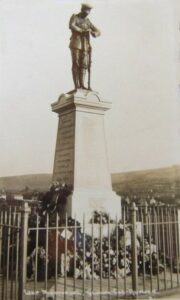
The Great War, 1914-1918
Frederick Brooks, Private, Worcestershire Regiment. Frederick was born in London in 1888. He had worked at Gwaun-cae-Gurwen as a collier for several years prior to the war, before enlisting enlisted into the Worcestershire Regiment. Frederick was based at Plymouth with the 5th (Reserve) Battalion, when on 19 June 1916 he murdered a 12-year-old girl, Ellen Clara Gregory. He was captured by the police soon after and admitted strangling the girl in a fit of rage. Frederick was hung in Exeter Prison on 12 December 1916. The 28-year-old was buried in Exeter Prison Cemetery. Although he is obviously not commemorated on the Gwaun-cae-Gurwen war memorial and does not deserve to be due to his crime and subsequent punishment, Frederick’s story is of local interest, so I have decided to add him here.
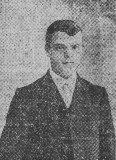
Frederick Collins. Frederick cannot be positively identified, but his name was a later addition to the memorial, so he probably died post war. He was quite possibly a medic with the Royal Army Medical Corps, who had given some enlightening talks about his war experiences in France whilst on leave in the summer of 1915.
George Cook, Private, 18320, Worcestershire Regiment. George was the son of John and Sarah Cook, of Greenfield Cottage, Garnant. He resided at Pontardawe Road, Cwmgorse prior to the war, and worked as a collier. George was engaged to Carrie James, of Cwmgorse. He enlisted at Cwmgorse into the Worcestershire Regiment in August 1914 and was posted to the 11th Battalion, Worcestershire Regiment, which was attached to 78 Brigade, 26th Division. The Division landed at Boulogne on 23 September 1915 but were soon moved again, arriving in Salonika during November that year, to join the Anglo-French force being built up to aid the Greeks, following the invasion of neighbouring Serbia by the Bulgarians. Here the division fought a prolonged campaign against the combined Bulgarian and Turkish forces. George was killed in action in Salonika, during the Battle of Doiran on 25 April 1917. The 23-year-old has no known grave and is commemorated on the Doiran Memorial, Salonika. Corrie sadly, yet strangely, passed away on the same day that George was killed.
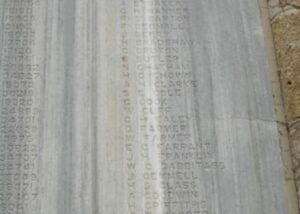
David Davies, Private, 25987, Welsh Regiment. David was born at Llanguicke in 1870. He was living with his sister, Elizabeth John and her husband Nicholas, at Park Terrace, Pantyffynon when war broke out. David enlisted at Ammanford into the 17th Battalion, Welsh Regiment. The battalion was raised in January 1915 as a Bantam Battalion, made up of men of below average height, and initially went to Porthcawl attached to the 43rd (Welsh) Division. During July 1915 the battalion moved to Prees Heath to join 119 Brigade, 40th (Bantam) Division and landed in France with the Division in June 1916. The Division moved to positions around Lillers before taking over the North Maroc Sector, near Loos, for trench initiation and once acclimatised was left to hold the sector itself over the coming months. The infantry battalions of the Division then began the usual routines of rotating for duty in the trenches: normally four days in the front line; four in support and four in reserve. David had only been in France two weeks when he was killed by German artillery fire on 19 June 1916. The 46-year-old is buried in Maroc British Cemetery, Grenay, France.

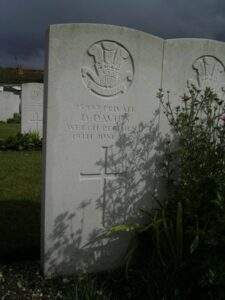
George Henry Hopkins Davis, Private, 260431, Gloucester Regiment. George was born at Alcester, Warwickshire, the illegitimate son of Edith Fanny Davis. His mother married Herbert Quiney in 1891, and George moved in with his mother and her husband at 1, St. Peter’s Street, Worcester. George left home to find work in the South Wales coalfields as a young man. He married Sarah Ann Gammon in 1910 and the couple settled at 41, Clwyd Road, Gwaun-cae-Gurwen, where their two sons were later born. George enlisted at Cardiff into the Brecknockshire Battalion, South Wales Borderers, but was later transferred to the Monmouthshire Regiment. Upon being drafted to France he was posted to the 12th Battalion, Gloucester Regiment, which was attached to 95 Brigade, 5th Division. George joined the battalion in 1917, in time to take part in the Passchendaele offensive. He was killed during the drive towards Polygon Wood, on 9 October 1917. The 31-year-old has no known grave, and is commemorated on the Tyne Cot Memorial, Belgium. His widow, Sarah, later moved to Tadpole Cottage, Spetchley, Worcester. His half-brother, Frank Wilbert Quiney, was killed in 1918.
Richard Davies, Private, 48784, Royal Army Medical Corps. Richard was born in 1885, the son of David and Sarah Davies, of 33, Frederick Street, Ferndale. He left home as a young man and by 1911 was residing at Blue Cottage, Church Street, Cwmgorse, where he worked as a coal hewer. Richard enlisting into the Welsh Regiment soon after the outbreak of war, but soon transferred to the Royal Army Medical Corps. He landed in France with the 38th (Welsh) Division on 2 December 1915, but at some time later was transferred to the 58th Field Ambulance, RAMC, which was attached to the 19th (Western) Division. Richard would have seen action on the Somme in 1916, and the following year was with the division when it fought at Messines and at Ypres, during the Passchendaele offensive. The Division wintered in the Cambrai sector, following the closure of the Battle of Cambrai, and was holding a section of the line in the Flesquières Salient. On 21 March 1918 the Germans launched the first of three offensives on to the section of the front running from Flesquières to St. Quentin, and the 19th Division was thrown into desperate fighting as it was pushed back over the coming days. Richard was badly wounded while dressing a wounded man during the German Somme offensive, and died of his wounds on 24 March 1918. The 32-year-old is buried in Lebucquière Communal Cemetery Extension, France.

William James Davies, Sergeant, 52767, Welsh Regiment. William was born at Mountain Ash in 1890. He was raised by his grandparents, then by an uncle, before moving to 20, Brook Terrace, Gwaun-cae-Gurwen. William married Beatrice Morgan in 1912, and the couple had two daughters in the coming years. He enlisted at Cardiff into the army, and at some time in 1917 was drafted to the Middle East, joining the 8th Battalion, Welsh Regiment, which was attached to 40 Brigade, 13th (Western) Division. The Division had seen action at Gallipoli in 1915 before being evacuated to Egypt, then in February 1916 the Division began to move to Mesopotamia, to strengthen the force being assembled for the relief of the besieged garrison at Kut al Amara. By 27 March, the Division had assembled near Sheikh Saad and came under orders of the Tigris Corps, and then took part in the attempts to relieve Kut. However, after these efforts failed and Kut fell, the British force in the theatre was built up and reorganised. The Division then took part in several operations to push the Turks from Persia, under very trying conditions, of unbearable heat, William took ill and was hospitalised in India, where he died of an abscess on his liver on 31 October 1918. The 28-year-old is buried in Kirkee New Cemetery, India.
Thomas Evans, Private, 2057, Royal Army Medical Corps. Thomas was born at Llandeilo in 1894, the son of Thomas Evans and Caroline Evans (nee Jones). The family had moved to 28, Church Street, Cwmgorse by 1900, and Thomas worked as a miner at Gwaun-cae-Gurwen prior to the war. He enlisted at Swansea into the Royal Army Medical Corps and was posted to the 3rd Welsh Field Ambulance, which was attached to the Welsh Division. The division moved to Pembroke Dock upon mobilisation, then moved to Northampton. In December the Division moved to Cambridge and then in May 1915 to Bedford, where the Division was numbered and the formation became 158 Brigade, 53rd (Welsh) Division. On 19 July 1915 the entire Division sailed from Devonport for Imbros and on 9 August 1915 landed at Suvla Bay. The infantry moved off the beaches across the Salt Lake, under shellfire, into the scrub covered Chocolate Hill, but due to a lack of maps and no knowledge of the terrain, many of the units became disorientated, and the situation became chaotic. It was soon after landing that Thomas was wounded, and he was evacuated aboard the Hospital Ship Clan McGillivray where he died of wounds on 15 August 1915. The 21-year-old was buried at sea, so is commemorated on the Helles Memorial, Gallipoli.
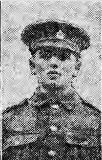
Charles Field, Stoker 1st Class, Dev/277845, Royal Navy. Charles was born at Briton Ferry on 12 July 1875, the son of Isaac Field and Elizabeth Field (nee Langdon). He had originally enlisted into the Royal Navy on 11 September 1894, and after twelve years service, retired and joined the Royal Fleet Reserve. Upon returning to civilian life, Charles married Eva Emma Pitman at Baglan on 27 July 1907 and the couple moved to 40, Avon Terrace, Cwmgorse, where Charles found work as an underground labourer. At the outbreak of war, Charles was mobilised from the Reserve, joining Nelson Battalion, Royal Naval Division. He served during the Defence of Antwerp in 1914, and also possibly served with the RND at Gallipoli, landing on 25 April 1915. Charles transferred back to the Fleet on 26 July 1915, serving with them until demobilisation on 4 February 1919. He died of heart disease contracted during his war service on 15 February 1920, aged 44. His place of burial is not presently known. Charles died as a result of his service, but is not commemorated on the Gwaun-cae-Gurwen war memorial, or by the Commonwealth War Graves Commission.
Thomas Hawk, Private, 6749, Welsh Regiment. Thomas was born at Merthyr in 1882, the son of William James Hawk and Sylvia Hawk (nee John). The family later moved to 5, St. David’s Street, Gwaun-Cae-Gurwen. Thomas had enlisted into the Welsh Regiment as a young man on 24 January 1901 and by 1911 was in Egypt serving with the 1st Battalion, Welsh Regiment. He left the army soon afterwards and, in the summer of 1914, married Caroline Fowler. The couple then settled at 22, Brook Terrace, Gwaun-Cae-Gurwen. As an army reservist, Thomas was mobilised at the outbreak of war and was posted to the 2nd Battalion, Welsh Regiment. The battalion entrained for the south coast within days of war breaking out and on 13 August 1914 landed in France. The battalion was attached to 3 Brigade, 1st Division and entrained for the Belgian frontier, near the town of Mons. The Division then took part in the Battle of Mons on 23 August, following the German invasion of the low countries, and in the epic withdrawal from Mons to the River Marne, where the German drive on Paris was halted. The Germans then withdrew north and took up defensive positions north of the River Aisne, along the Chemin des Dames Ridge and the BEF advanced before launching a frontal attack upon the German positions. Thomas was killed during a desperate action at Chivy Ridge, near Vendresse, on 26 September 1914. The 32-year-old has no known grave and is commemorated on the La Ferté-Sous-Jouarre Memorial, France.
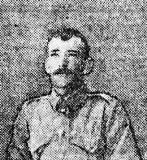
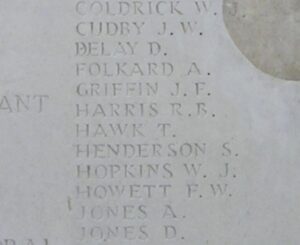
David Howells, Private, 20188, Welsh Regiment. David was born at Llangyfelach in 1888, the son of George Howells and Mary Howells (nee Rees). The family then moved to 3, Brook Terrace, Gwaun-cae-Gurwen. David married Caroline Griffiths, a single mother, in the summer of 1913 and the couple moved to 80, High Street, Tumble, where David worked as a collier. He enlisted at Llanelli into the 15th Battalion, Welsh Regiment, during a recruitment drive soon after the outbreak of war. The battalion, known as the Carmarthen Pals battalion, was attached to 114 Brigade, 38th (Welsh) Division. On 2 December 1915 the battalion moved to France, and the entire Division moved to the Fleurbaix sector, where it was initiated into trench warfare. On 9 March 1916 the Battalion was holding the line at Gorre when the Germans exploded a mine under their forward positions, killing seven men, including David. The 27-year-old is buried in Guards Cemetery, Windy Corner, Cuinchy, France.
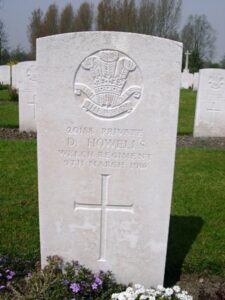
Thomas Howells, Driver, T2/SR/03046, Royal Army Service Corps. Thomas was born at Morriston in about 1877, the son of John Howells and Lettice Howells (nee Jones). By 1911 he was lodging with his uncle, William Jones, at Brown Hill House, High Stret, Cwmgorse, and was working as a coal miner. Thomas had served in the army for eight years as a young man, and on 18 February 1915 re-enlisted at Cardiff, being posted to the Horse Transport, Army Service Corps. He was posted to the Depot at Aldershot for training, before embarking for France aboard the SS Alexandra at Southampton on 18 March 1915, disembarking at Le Havre the following day. Thomas served on the Western Front for the duration of the war, with various units. He was first attached to the Indian Cavalry Division, before being posted to the 5th Entrenching Battalion and came home on leave in December 1915 before returning to France, joining the 4th Entrenching Battalion. He returned home on leave again in December 1916, and upon returning to France joined the Third Army A. H. Corps. Thomas came home on leave again, for the final time, in December 1917 and upon returning to France in January was posted to the 180th Labour Company. Thomas survived the war and remained on the Western Front, attached to the 180th Labour Company, assisting with battlefield clearances. Sadly, he became ill at the beginning of February 1919 and was invalided to the 1st Casualty Clearing Station at Mons, where he died of broncho-pneumonia on 17 February 1919. The 43-year-old was buried in Mons (Bergen) Communal Cemetery, Belgium.
Evan James, MM, Able Seaman, Z/571, Royal Naval Volunteer Reserve. Evan was born on 23 September 1893, the son of Thomas James and Catherine James (nee Evans), of 71, Star Terrace, Cwmgorse. He worked as a collier prior to enlisting into the Royal Naval Volunteer Reserve on 9 January 1915 and was posted to Crystal Palace for training. Evan was then posted to ‘D’ Company, Hood Battalion, which was attached to 189 Brigade, 63rd (Royal Naval) Division. The Division, made up entirely of surplus Royal Navy reservists, was then sent to Gallipoli, landing on 25 April 1915 and saw heavy fighting over the coming months. Evan was hospitalised in June, suffering from enteritis, and was evacuated to hospital in Malta. Evan eventually re-joined his battalion at Gallipoli in October, and was present when the Royal Naval Division was evacuated from Gallipoli in January 1916. The division then moved to Egypt, before moving to France in May 1916 and moved to Abbeville, on the Somme estuary. It was almost two months before the division was moved into the line, taking up positions at Souchez, north of Arras, by 19 July and remained there until the first week of October when it transferred south to take part in the great Somme offensive. The Royal Naval Division then took part in the Battle of the Ancre, and the resulting Operations on the Ancre, seeing heavy fighting on the northern side of the river valley. Evan won the Military Medal for Bravery in the Field on 13 November 1916, but was wounded that same day, suffering a gunshot wound to his left leg. Evan had his leg amputated, but sadly died of his wounds in the 13th General Hospital at Boulogne on 22 November 1916. The 23-year-old was buried in Boulogne Eastern Cemetery, France.
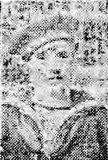
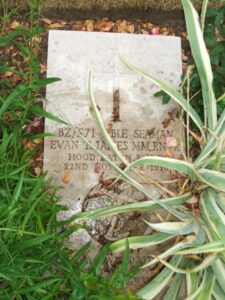
Morgan Price James, Private, 14833, King’s Own Yorkshire Light Infantry. Morgan was the son of Mary Thomas, of Cilrhedyn Villa, Colbren Road, Gwaun-cae-Gurwen. His story is one of some mystery, as it took a lot of work to finally identify him, due to errors in official records which led to him being commemorated at James Morgan by the CWGC. Morgan enlisted at Cardiff into the army, and was posted to the 7th Battalion, King’s Own Yorkshire Light Infantry. The battalion was attached to 61 Brigade, 20th (Light) Division, and moved to France in September 1915. The division was thrust into action at Fromelles within weeks of landing, before being transferred to Ypres. It remained here for several months, taking part in the Battle for Mount Sorrel, before being posted to the Somme sector in September 1916. Morgan was killed while the battalion was in the line near Ypres on 30 June 1916, while attempting to rescue a wounded comrade. The battalion must have been attacked by German flamethrowers, as an article in a local newspaper stated that a charred photograph of Morgan with his family was taken from his pocket and sent home to his mother. Morgan was 22 years old, and is buried at White House Cemetery, St. Jean-les-Ypres. He was shown on both the Soldier’s Died in the Great War and the Commonwealth War Graves Commission as being named James Morgan, which made identifying him virtually impossible. This was until a small article was discovered while trawling through archives of Llais Llafur. He was also incorrectly shown as serving with the 9th KOYLI, which was on the Somme when he died, so I passed my research onto the CWGC in order to get his name and headstone corrected, which it duly was, after some trials and tribulations. Some poetry was published in his honour in the ‘Amman Valley Chronicle’ of 24 August 1916, entitled ‘Deigryn Hiraeth’, which translates as ‘A tear in grief’.
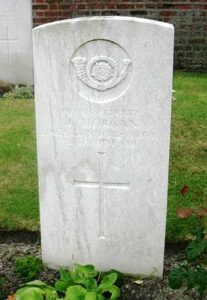
John James, Private. John cannot be identified, but lived at the Old Star, Cwmgorse. John Parry Jones, who was killed in 1918, also lodged there prior to the war, so could this be an error on the memorial?
David Jones, Private, Welsh Regiment. This man cannot be positively identified, but he lived at High Street, and served with the Welsh Regiment.
Evan Jones, MM, Private, 28047, Welsh Regiment. Evan was born in Birmingham in 1897, the son of Evan Jones and Emma Jones (nee Field). The family had moved to Star Villa, Cwmgorse by 1911. Evan enlisted into the 18th Battalion, Welsh Regiment during the spring of 1915. The battalion was raised in January 1915 as a Bantam Battalion, made up of men of below average height, and initially went to Porthcawl attached to the 43rd (Welsh) Division. During July 1915 the battalion moved to Prees Heath to join 119 Brigade, 40th (Bantam) Division and landed in France with the Division in June 1916. The Division moved to positions around Lillers before taking over the North Maroc Sector, near Loos, for trench initiation and once acclimatised was left to hold the sector itself over the coming months. The infantry battalions of the Division then began the usual routines of rotating for duty in the trenches: normally four days in the front line; four in support and four in reserve. Late in 1916 the Division moved south to the Somme, and fought at the Battle of the Ancre, before remaining in the sector over the winter. In March 1917 the Germans withdrew to their shortened line, called the Hindenburg Line, and the 40th Division was among the units which followed the withdrawal. Later in the year the Division took part in the Battle of Cambrai and launched an attack on Bourlon Wood on 23 November 1917. The attack was carried out by 119 Brigade, led by the 12th SWB and 19th RWF. The 17th Welsh was in support for the initial assault, but was soon ordered to advance, to support the two attacking battalions. Heavy fighting raged within the wood over the coming days, with the 18th Welsh also being thrown forwards into the fight, and the Division suffered terribly. Evan was killed at Bourlon Wood on 27 November 1917. The 20-year-old is buried in Rocquigny-Equancourt Road British Cemetery, Manancourt, France. Evan was the recipient of the Military Medal, which was noted in the Amman Valley Chronicle of 28 December 1916 as being for ‘conspicuous bravery against great odds’.
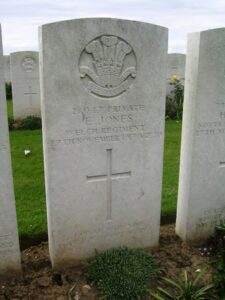
John Parry Jones, Private, 64502, Welsh Regiment. John was born at Groes, Denbighshire in about 1883. Prior to the war he had moved to Gwaun-cae-Gurwen to work as a collier, and resided with Mrs. Mary Thomas, of the Old Star Inn, Cwmgorse. He enlisted at Swansea in February 1916 into the 4th (Reserve) Battalion, Welsh Regiment. John didn’t get posted to France until 30 March 1918, and was posted to the 14th Battalion, Welsh Regiment, which was attached to 114 Brigade, 38th (Welsh) Division. The division moved from Armentieres to positions north of Albert, at Bouzincourt Ridge, at the end of March 1918, relieving the battered 2nd and 47th Divisions. It held this sector, again carrying out minor operations and trench raids, over the coming months, before taking part in the great offensive of 21 August 1918, and began its advance towards the Hindenburg Line. Over the coming days the division recaptured Thiepval Ridge, Pozieres, Mametz Wood and High Wood, whilst advancing across the old Somme battlefields of 1916. The advance saw the Division take part in several costly assaults over the coming weeks, famously crossing the Canal du Nord. On 4 October the 14th Welsh moved into the old German trenches in the Hindenburg Line. On 8 October they attacked Malincourt, which was a strongly defended German position in the Hindenburg Support line. John was shot during the attack, and brought to the 131st Field Ambulance for treatment, dying the same day, 8 October 1918. The 35-year-old is buried in Marcoing British Cemetery, France.
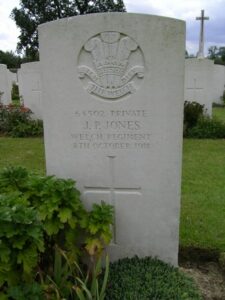
John Rees Jones, Private, 203373, Welsh Regiment. John, known as Rees, was born in Llanybydder in 1883, the son of Rees Jones and Elizabeth Jones (nee Evans), of Rhiw Bedr, Llanybydder. His mother died when he was young and his father moved with Rees and three of his siblings to Maesywernen, Cowell Road, Garnant by 1911, and then moved again to 61, Colbren Road, Gwaun-cae-Gurwen prior to the war. Rees worked there as a stone mason prior to the war. He enlisted at Gwaun-Cae-Gurwen into the 4th Battalion, Welsh Regiment and was posted to Bush Camp at Pembroke for training, before being posted to the 11th Battalion, Welsh Regiment, which was known as the Cardiff Pals battalion, and was attached to 67 Brigade, 22nd Division. In December the battalion moved to St. Leonard’s in billets, then completed its training at Seaford and Aldershot before embarking for France and landed at Boulogne on 6 September 1915. The Division’s stay in France was to be very short, however, as on 27 October 1915 the Division, having been moved by train to Marseilles, began to embark for Salonika as part of an Anglo-French force sent to hold the Greek border, due to the invasion of neighbouring Serbia by a combined Austro-Hungarian force. The Division remained in the Salonika theatre for the rest of the war, taking part in the Retreat from Serbia during December 1915. Large battles were fought in August 1916, at the battle of Horseshoe Hill, then in September 1916 at the battle of Machukovo. Between 24 April and 9 May 1917 the Division fought at the battle of Doiran, and then on 18 September 1918 at the Second Battle of Doiran. Rees was attached to the 67th Battalion Machine Gun Corps at some time during the campaign. He was serving with the battalion when he took ill and died of influenza and pneumonia on 6 October 1918. The 35-year-old is buried in Mikra British Cemetery, Kalamaria. His brother, John Jones, of Llanybydder, was killed in Mesopotamia in 1917.
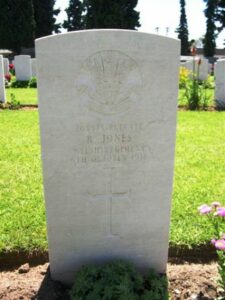
William Jones, Gunner, W/1938, Royal Field Artillery. William was born at Llanarth, Cardiganshire in 1879, the son of Evan Jones and Ann Jones. The family moved to Morriston by 1881. William resided at 7, High Street, Cwmgorse prior to the war and worked as a coalminer. William enlisted at Morriston into the Royal Field Artillery, and was posted to ‘A’ Battery, 119th Brigade, Royal Field Artillery, which was attached to the 38th (Welsh) Division. The division trained in North Wales before moving to Winchester in the summer of 1915 to complete its training. The Division moved to France on 2 December 1915 and moved to the Nursery Sector near Fleurbaix for trench initiation alongside the Guards Division. The Division then held a sector of the line near Cuinchy before marching south to the Somme sector in June 1916 to take part in the assault on Mametz Wood. The first attack on the wood was launched on a two-battalion front on 7 July, but failed, and the Divisional Commander, Sir Ivor Philipps, was replaced before the Division attacked again on a two Brigade front on 10 July 1916. After two days of ferocious hand-to-hand fighting, the wood was cleared up to its northern edge, before the battered Division was relieved. It then took over a section of the front at Hébuterne before moving to the Ypres Salient, and taking over the Canal Bank sector at Boesinghe. The infantry battalions of the Division then began carrying out the normal pattern of rotation in the trenches, four days in the front, four in support and four in reserve, whilst also working on trench improvement, digging new trenches, and also carrying out regular patrols and trench raids. William came back to Cwmgorse on leave in January 1917 and was the recipient of a reception party at Tabernacle Chapel, where he was awarded a sum of money for his efforts during the war. William returned to the front soon afterwards, re-joining his battery at Ypres. On 31 July 1917 the Division launched its famous assault on the Pilckem Ridge, capturing Iron Cross and reaching its objective of the Steenbeek, then played a supporting role in the Battle of Langemarck. The Division was transferred to the Sailly-sur-la-Lys sector in September, and remained in the area over the winter. William became ill soon after the division moved to Armentieres and was evacuated to hospital at Wimereux where he died on 1 October 1917. The 38-year-old is buried in Wimereux Communal Cemetery, France.
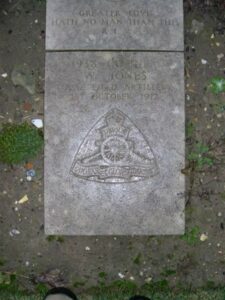
Thomas Kinsey, Private, 2920, Army Cyclist Corps. Thomas was born at Herbrandston, Pembrokeshire in 1892, the son of Jonathan Kinsey and Emily Kinsey (nee Lloyd). The family had moved to Gwaun-cae-Gurwen prior to 1901. Thomas worked as a collier prior to the war. He enlisted at Ammanford into the 9th Battalion, Royal Welsh Fusiliers on 9 September 1914, but was instead posted to the Depot at Wrexham. On 30 December he was posted to the 25th Division Cyclist Company, and landed in France on 26 September 1915, before the division moved to the Vimy sector. Cyclist battalions were utilised for reconnaissance and communications work due to their mobility, so Thomas would have been basically utilised as a despatch rider, as the static conditions of trench warfare at the front meant no need for reconnaissance work. On 11 May 1916 Thomas was transferred to the XVII Corps Cyclist Battalion, and remained with the battalion for the remainder of his time at war. XVII Corps was in the Arras sector and saw heavy fighting during the Battle of Arras in the spring of 1917, and then at Cambrai later that year. The same sector then came under intense pressure during the opening phase of Operation Michael, the German Spring offensive, of March 1918 and enjoyed a lull during the summer before the Allies launched their great offensive of 21 August and began pushing towards the Hindenburg Line. Thomas was killed in action whilst supporting the assault of the 63rd (Royal Naval) Division upon the outer Hindenburg Line defences near Moeuvres on 4 September 1918. The 26-year-old has no known grave, and is commemorated on the Vis-En-Artois Memorial, France.
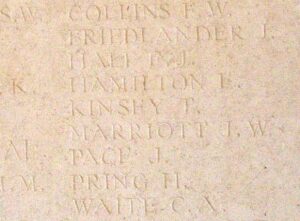
Arthur John Lavington, Sergeant, 7851, Coldstream Guards. Arthur was born at Ealing in 1886, the son of Arthur John Lavington and Elizabeth Lavington (nee Barnett). His parents later moved to 1, Montague Villas, Newbury, while Arthur left home as a young man to enlist into the army. His brother, Herbert Lavington, was a photographer and newsagent and had moved to 4, Church Street, Cwmgorse by 1911. Arthur frequently visited his brother and was well known at Cwmgorse prior to the war. Arthur embarked for France with the 2nd Battalion, Coldstream Guards on 12 August 1914. The battalion was attached to the 4th (Guards) Brigade, 2nd Division and moved to the Belgian frontier, near Mons. The division then saw heavy fighting during the Battle of Mons, following the German attack on 23 August, and retreated southwards with the rest of the BEF, fighting at the Affair of Landrecies, the Rearguard Actions of Villers-Cotterets, and at the Battle of the Marne where the German offensive was eventually stopped. The Germans then withdrew north and took up defensive positions north of the River Aisne, along the Chemin des Dames Ridge and the BEF advanced before launching a frontal attack upon the German positions. The resulting Battle of the Aisne, resulted in a stalemate which laid the foundation for the beginning of the Western Front, a long fortified entrenchment which ultimately lasted for most of the war. The BEF then began moving to Flanders on 17 October, before advancing from Poperinghe past endless numbers of refugees and took up positions guarding the strategically vital city of Ypres, the 2nd Division taking up positions northwest of Zonnebeke by 21 October. Later that day the neighbouring 1st Division was attacked by hordes of Germans, mainly young student-soldiers, who were mown down by the highly trained British soldiers. The Germans maintained their attacks over the coming days but were held at bay, sustaining terrible losses, and the line here stabilised, and the BEF adjusted its positions before being hit hard by the Germans on 31 October 1914, the height of the First Battle of Ypres. Following weeks of heavy fighting, the German sweep through Flanders was eventually stopped, and the 2nd Division remained there throughout the first winter of the war. In 1915 the division took part in the Battle of Festubert, and in September fought at the Battle of Loos, and subsequent Action of Hohenzollern Redoubt. The 2nd Battalion, Coldstream Guards moved to Loos in August 1915, joining 1st Guards Brigade, Guards Division. The division saw its first action at Loos the following month, suffering heavy casualties, before moving back to Ypres to rebuild, and Arthur was lucky enough to return to Cwmgorse on leave, rejoining his battalion east of Ypres. Arthur was killed in action here during a routine tour in the line at Potijze on 24 April 1916. The 29-year-old is buried in Potijze Burial Ground Cemetery, Belgium. Arthur is not commemorated locally.
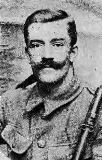
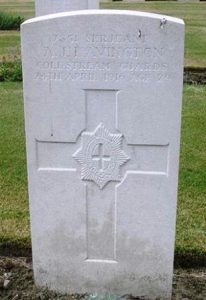
William Richard Maidment, Private, 15173, South Wales Borderers. William was born in Bassaleg, near Newport in 1870, the son of John and Elizabeth Maidment. He enlisted into the army in November 1893 and served for several years with the South Wales Borderers, before leaving the army and moved to High Street, Cwmgorse, where William gained work as a Collier. Being an army reservist, William was mobilised soon after the outbreak of war, re-joining the South Wales Borderers. He was drafted to France on 10 December 1914 and entrained for Flanders, joining the 1st Battalion, South Wales Borderers, which was attached to 3 Brigade, 1st Division. The division had suffered terrible casualties during its vital actions during the defence of Ypres the previous weeks, and had just moved to new positions near Outtersteene to rebuild. On 20 December the now rebuilt 1st SWB left for Merris, before the 1st Division took up new positions in the line at Festubert, a wet marshy area. On Christmas Day the men were in the trenches, cold and wet, when they were presented with their Princess Mary gift tins, which contained cards and gifts on behalf of the Royal Family. The line was relatively quiet over this period, but the trenches were flooded and in a terrible state. On 4 January 1915 the 1st SWB were relieved and moved back to Bethune, where the men were allowed to bathe and received issues of clean clothes, before moving back into the Festubert trenches four days later. The battalion remained in the line here until 14 January when it relieved the Black Watch at Givenchy. At dawn on 25 January 1915 the Germans hit their lines with an intensive artillery bombardment, before launching an infantry assault, breaking through 100 yards of trench and reaching Givenchy village. Heavy fighting raged throughout the day as the Germans were driven back and the line regained. Settling back into the usual routine of static trench warfare, the division remained in the line north-east of Bethune, near Richebourg over the coming weeks. The 1st Division took part in its first major action of 1915 here on 9 May 1915, during the Battle of Aubers Ridge, when it attacked alongside the Meerut Division. The attack of 3 Brigade was held up by a flooded ditch, which the men forded, before being hit by heavy machine-gun fire, and a large number of casualties were suffered before the survivors withdrew. After the battle of Aubers, 3 Brigade took over a section of old French trenches, where it received drafts of reinforcements. On 20 May, the Brigade moved to the Cuinchy area, where it endured a great deal of bombing and rifle grenading, then at the latter end of June the entire division moved to the Vermelles area, in preparation for the battle of Loos. The Battle of Loos was launched on 25 September 1915, following the release of large quantities of poison gas by the British. 3 Brigade moved off with the 2nd Munsters on the right, the 2nd Welsh in echelon, to their left, and the 1st SWB in support. The gas had blown back over the British lines, so conditions during the advance were horrendous, then whilst advancing past the Vermelles-Hulluch Road the Brigade came under heavy machine-gun fire. William was killed in action here during further terrible fighting on 28 September 1915. The 45-year-old has no known grave, and is commemorated on the Loos Memorial, France.
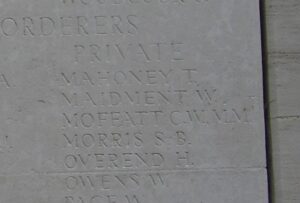
Bertie Arthur Charles Milham, Rifleman, S/6526, Rifle Brigade. Bertie was born in 1880, the son of William Milham and Sarah Milham (nee Pizzey), of 32, Barrett Road, Norbiton, Kingston, Surrey. He enlisted into the army as a young man, joining the Rifle Brigade in 1901 and served for several years before leaving the army and becoming a reservist. Bertie then moved to Gwaun-cae-Gurwen where he gained work as a bricklayer. He married the widowed Mary Ann Ford (nee Thomas) on 7 October 1911 and the couple settled at 22, Tonyrefel, Gwaun-cae-Gurwen. As a reservist, Bertie was mobilised soon after the outbreak of war, joining his old regiment, the Rifle Brigade again. He was drafted to France on 16 March 1915, joining the 2nd Battalion, Rifle Brigade, which was in the Bois Grenier area, attached to 25 Brigade, 8th Division. The division had just taken part in its first major action of the war, during the Battle of Neuve Chapelle from 10 March to 13 March and was rebuilding its strength when Bertie arrived. The division then took part in the Battle of Aubers Ridge on 9 May, suffering heavily again for no gain. On 25 September 1915 the division took part in the diversionary attack known as the Action of Bois Grenier, which was intended to draw German attention away from the main offensive at Loos and the 2nd Rifle Brigade alone suffered over 200 casualties during the day. The division remained in the area over the winter, then in March 1916 was relieved and began moving south into the Somme sector and took over positions east of Albert. The division took part in the opening assault of the Battle of the Somme, against Ovillers-La Boiselle, on 1 July 1916, suffering terrible casualties. The battered division was relieved in the coming days and moved into the rear areas to rest and rebuild before moving to the Hohenzollern Sector near Loos. At the beginning of October the division was relieved again and moved back into the Somme sector, to take part in the latter stages of the offensive and took over positions at Misty Trench, near Lesboeufs, by 19 October where the men prepared for a forthcoming attack. At dawn on 23 October 1916, the 2nd Rifle Brigade launched an assault from Misty Trench against Zenith Trench, behind a creeping artillery barrage. Bertie was killed in action during the fighting that day. The 36-year-old has no known grave and is commemorated on the Thiepval Memorial, France.
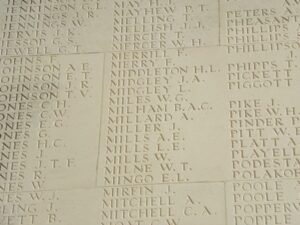
Frederick George Mitchell, Private, 14355, Royal Welsh Fusiliers. Fred was born in Morriston in 1889, the son of David Mitchell and Rachel Mitchell (nee Hannah). The family moved to Council Houses, Abernant Road, Gwaun-cae-Gurwen at some time before 1904. Frederick worked on the railways prior to enlisting at Tumble into the 11th Battalion, Royal Welsh Fusiliers soon after the outbreak of war. The battalion had formed at Wrexham in September 1914, before moving to Seaford to join 67 Brigade, 22nd Division. In December the battalion moved to St. Leonard’s in billets, then completed its training at Seaford and Aldershot before embarking for France and landed at Boulogne on 6 September 1915. The Division’s stay in France was to be very short, however, as on 27 October 1915 the Division, having been moved by train to Marseilles, began to embark for Salonika as part of an Anglo-French force sent to hold the Greek border, due to the invasion of neighbouring Serbia by a combined Austro-Hungarian force. The Division remained in the Salonika theatre for the rest of the war, after taking part in the Retreat from Serbia during December 1915. Fred came home on leave in July 1917 and was then posted to France, joining the 9th Battalion, Royal Welsh Fusiliers, which was south of Ypres, attached to 58 Brigade, 19th (Western) Division. The division had just taken part in the assault on Messines Ridge on 7 June, which was famously preceded by the blowing of a series of 19 huge underground mines. The 19th Division saw heavy fighting during the battle, then enjoyed a short spell in reserve before moving back into the line on 11 September, taking over a section of trenches running from the Ypres-Comines Canal to Belgian Wood. The Division wintered in the Cambrai sector, following the closure of the Battle of Cambrai, and was holding a section of the line in the Flesquières Salient. On 21 March 1918 the Germans launched the first of three offensives on to the section of the front running from Flesquières to St. Quentin, and the 19th Division was thrown into desperate fighting as it was pushed back over the coming days. The battered Division was then moved to the Wytschaete sector to rest, but then became caught up in the second phase of the German offensive, which had been launched along the Lys Valley on 9 April, and again became caught up in desperate fighting. The 9th RWF was holding the line in front of Green Wood and Oostaverne when it was hit on 10 April, following a ferocious artillery bombardment, and became almost surrounded during a day of terrible fighting. The survivors withdrew to the Scherpenberg, before the division was reorganised and moved back forward into the line between Maedelstede Farm and Spanbroekmolen, which it held over the coming days. Fred was posted as missing at some time between 8 and 18 April 1918. The 28-year-old was later declared as having been killed in action on the latter date. He has no known grave and is commemorated on the Tyne Cot Memorial, Belgium.
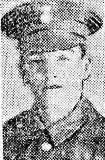
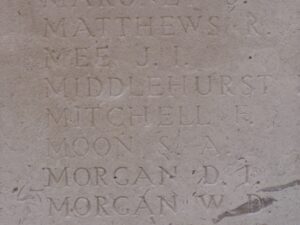
Morgan Morris, Private, 1504, Australian Infantry. Morgan was born at Gwaun-cae-Gurwen in 1894, the son of John Morris and Mary Morris (nee Jones). John died in 1905, so Morgan went to live with his paternal grandmother, Mary Morris. He worked as a coal miner before emigrating to live with his maternal grandparents in Phoenix, Arizona, in 1913, and his mother joined him later that year. He then went to Australia at the age of 20, where he studied as a Mining Engineer. He resided at Raymond Street, Collie, Western Australia prior to the war, and at the outbreak of hostilities enlisted at Blackboy Hill into the 16th Battalion, Australian Infantry. The battalion moved to Egypt at the end of 1914, where it trained in preparation for a move to France. Morgan was attached to the 2nd reinforcement draft to the battalion, and embarked at Fremantle on 22 February 1915. The Australians move to France was however cancelled, and instead, the Australians were used during the landings on Gallipoli. Morgan landed with his battalion at ANZAC Cove, Gallipoli on 25 April 1915. He took part in some heavy fighting during his short time at war, and was killed in action on 9 May 1915. The 21-year-old has no known grave and is commemorated on the Lone Pine Memorial, Gallipoli.
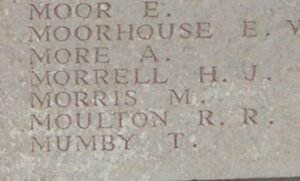
William James Newlands, Able Seaman, Z/2219, Royal Naval Volunteer Reserve. William was born on 10 May 1897, the son of James Newlands and Mary Newlands (nee James), of Rhydyfro, Pontardawe. The family moved to 44, High Street, Cwmgorse prior to the war. William enlisted on 25 October 1915, and was posted to France on 18 September 1916, joining Hood Battalion, Royal Naval Volunteer Reserve, which was attached to 189 Brigade, 63rd (Royal Naval) Division. The division was in the Arras sector, near Souchez, when William arrived, then moved south taking over the Hamel Sector on the Somme and saw heavy fighting in the Ancre Valley during the Battle of the Ancre during the latter stages of the Battle of the Somme. The division then moved to the Somme estuary near Le Crotoy to rebuild, remaining there until after Christmas, when the division moved to St. Quentin, on the coast, for training. By the middle of January 1917 the division had moved back into the Hamel Sector and at the beginning of February took part in an assault near Puisieux, suffering heavy casualties. The division remained in this particularly ferocious sector over the coming weeks, before being relieved and moved to positions near Arras, at Écoivres. On 23 April 1917, as part of the overall Battle of Arras, the Royal Naval Division launched an assault against the German held town of Gavrelle. William was killed in action here during the fighting that day. The 19-year-old has no known grave, and is commemorated on the Arras Memorial, France. William is not commemorated on the Gwaun-cae-Gurwen war memorial.
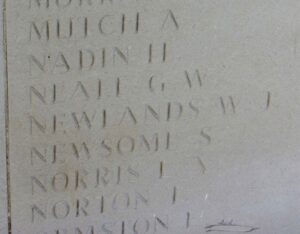
Edward Herbert Owen, Private, 24411, Welsh Regiment. Edward was born in 1896, the son of Moses Owen and Mary Ann Owen (nee Beaumont), of 40, Wyeview Terrace, Builth Road, Breconshire. He lived at Colbren Road, Cwmgorse prior to enlisting in the town into the 16th Battalion, Welsh Regiment in the spring of 1915. The battalion, known as the Cardiff City battalion, was raised at Cardiff in November 1914 by the Lord Mayor and Corporation, before moving to Colwyn Bay in December 1914, joining 130 Brigade, 43rd (Welsh) Division. On 29 April 1915 the formation became renumbered to 115 Brigade, 38th (Welsh) Division, before moving to Winchester to complete its training. The Division moved to France on 2 December 1915 and moved to the Nursery Sector near Fleurbaix for trench initiation alongside the Guards Division. The Division then held a sector of the line near Cuinchy before marching south to the Somme sector in June 1916 to take part in the assault on Mametz Wood. The first attack on the wood was launched on a two-battalion front on 7 July, but failed, and the Divisional Commander, Sir Ivor Philipps, was replaced before the Division attacked again on a two Brigade front on 10 July 1916. After two days of ferocious hand-to-hand fighting, the wood was cleared up to its northern edge, before the battered Division was relieved. It then took over a section of the front at Hébuterne before moving to the Ypres Salient, and taking over the Canal Bank sector at Boesinghe. The infantry battalions of the Division then began carrying out the normal pattern of rotation in the trenches, four days in the front, four in support and four in reserve, whilst also working on trench improvement, digging new trenches, and also carrying out regular patrols and trench raids. Edward was killed by German artillery fire whist the 16th Welsh were returning to Elverdinghe on 19 June 1917 after working on the Canal Bank at Boesinghe. The 21-year-old is buried in Poperinghe New Military Cemetery, Belgium.
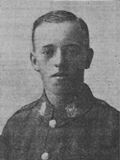
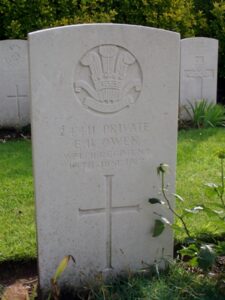
Frederick Richings, Private, 24460, Welsh Regiment. Frederick was born in 1890, the son of Henry Richings and Anne Richings (nee Harris), of Leigh, Worcestershire. He moved to the South Wales coalfields to find work as a young man and on 4 September 1911 married Ellen Hughes at Pontypridd. The couple then moved to 9, Brook Terrace, Gwaun-cae-Gurwen where their first daughter, Olive, was born the following year. Frederick enlisted at Cwmgorse into the 16th Battalion, Welsh Regiment in the spring of 1915. The battalion, known as the Cardiff City battalion, was raised at Cardiff in November 1914 by the Lord Mayor and Corporation, before moving to Colwyn Bay in December 1914, joining 130 Brigade, 43rd (Welsh) Division. On 29 April 1915 the formation became renumbered to 115 Brigade, 38th (Welsh) Division, before moving to Winchester to complete its training. The battalion moved to France on 4 December 1915 and moved to the Nursery Sector near Fleurbaix with the division for trench initiation alongside the Guards Division. The Division then held a sector of the line near Cuinchy before marching south to the Somme sector in June 1916 to take part in the assault on Mametz Wood. The first attack on the wood was launched on a two-battalion front on 7 July, but failed, and the Divisional Commander, Sir Ivor Philipps, was replaced before the Division attacked again on a two Brigade front on 10 July 1916. After two days of ferocious hand-to-hand fighting, the wood was cleared up to its northern edge, before the battered Division was relieved. It then took over a section of the front at Hébuterne before moving to the Ypres Salient, and taking over the Canal Bank sector at Boesinghe. The infantry battalions of the Division then began carrying out the normal pattern of rotation in the trenches, four days in the front, four in support and four in reserve, whilst also working on trench improvement, digging new trenches, and also carrying out regular patrols and trench raids. Frederick was killed soon after the move to Ypres, when the battalion was in trenches on the canal bank on 12 September 1916. The 26-year-old is buried in Essex Farm Cemetery, Belgium. Frederick is not commemorated on the Gwaun-cae-Gurwen war memorial.

Albert William Teague, Gunner, 71809, Royal Garrison Artillery. Albert was born at Ludlow on 8 November 1887, the son of William Teague and Elizabeth Teague (nee Felton). By 1911 Albert was residing at 4, Coelbren Road, Gwaun-Cae-Gurwen, where he worked as a weigh clerk. He enlisted at Brynamman into the Royal Garrison Artillery on 10 December 1915, and was posted to the 233rd Siege Battery, Royal Garrison Artillery, landing in France with the battery on 13 August 1916. The battery then moved to Bac St Maur to support the troops holding the line in front of Armentieres, remaining there until January 1917 when it moved to Vlamertinghe as part of 71 Heavy Artillery group. Albert was wounded on 20 April 1917, then after recovering, he re-joined the battery at Coxyde, on the Channel coast, where it was supporting a planned offensive, codenamed Operation Hush. Albert was killed in action here by German counter-battery fire on 21 July 1917. The 29-year-old is buried in Coxyde Military Cemetery, Belgium.
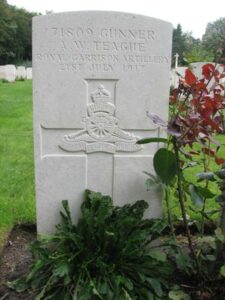
David Samuel Thomas, Gunner, W/4393, Royal Field Artillery. David was born at Llandeilo in 1893, the son of David Thomas and Sarah Ann Thomas. The family had moved to 2, Water Street, Gwaun-Cae-Gurwen by 1911 and David was working as a coal miner. He enlisted at Ammanford into the Welsh Divisional Royal Field Artillery in May 1915 and was posted to ‘C’ Battery, 121st Brigade, Royal Field Artillery. The Division had landed in France during December 1915 and had spent their first winter in the trenches near Armentieres. The division famously captured Mametz Wood in July 1916 during the Somme offensive, and in 1917 captured Pilckem Ridge, during the Battle of Passchendaele. After wintering at Armentieres, the division moved to the Somme in March 1918, and remained here until taking part in the great offensive from 21 August 1918, taking part in the advance to the Hindenburg Line. David married Sarah Rees, of Fernhill, New Road, Gwaun-cae-Gurwen whilst home on leave early in October 1918, before returning to France to re-join his battery. Sadly he took ill soon afterwards and died of influenza at the Base Hospital at Rouen on 13 November 1918. The 23-year-old is buried in St. Sever Cemetery Extension, Rouen, France.
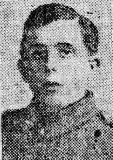
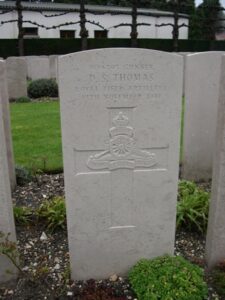
David William Thomas, Private, 1615, Welsh Regiment. David was born in Maesteg in 1893, the son of David Thomas. He married Mary Catherine Hart in 1912 and the couple moved to 32, Glantaf Cottages, Gwaun-cae-Gurwen, where David worked as a collier. He enlisted into the 1/6th Battalion, Welsh Regiment at some time prior to the war. The battalion was one of the first territorial units to move to France in August 1914. Initially, in late 1914 and early 1915, they were on lines of communication and in July 1915 were based in the Locre and Kemmel area, facing the Germans who were on the high ground at Spanbroekmolen. The battalion was in the trenches, but also doing work repairing trenches etc. On 5 July 1915 the battalion was attached to 84 Brigade, 28th Division, and took part in the Battle of Loos. On 23 October 1915 the battalion was transferred to 3 Brigade, 1st Division, which was also in the Loos Sector, and wintered at Loos, in horrific conditions. The 6th Welsh was holding the front line at Loos on 1 April 1916 when the Germans bombarded their positions, levelling the trench in places. David was among four men killed during the bombardment. The 24-year-old was buried in St. Patrick’s Cemetery, Loos, France.
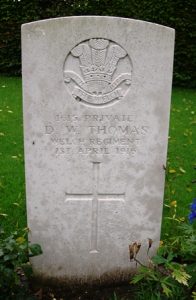
Ernest James Thomas, Private, 7286, Welsh Regiment. Ernest was born at Swansea in 1885, the son of David Thomas. He left home as a young man and enlisted into the Welsh Regiment on 28 October 1901. Ernest served for several years before leaving the army and being placed on the Army Reserve. He married Agnes Louisa Powney on 25 December 1907 and the couple set up home at 21, St. David Street, Gwaun-cae-Gurwen, where Ernest had found work as a colliery labourer. As an army reservist, he was mobilised at the outbreak of war and joined the 2nd Battalion, Welsh Regiment. The battalion entrained for the south coast within days of war breaking out and on 13 August 1914 landed in France. The battalion was attached to 3 Brigade, 1st Division and entrained for the Belgian frontier, near the town of Mons. The Division then took part in the Battle of Mons on 23 August, following the German invasion of the low countries, and in the epic withdrawal from Mons to the River Marne, where the German drive on Paris was halted. The Germans then withdrew north and took up defensive positions north of the River Aisne, along the Chemin des Dames Ridge and the BEF advanced before launching a frontal attack upon the German positions. Ernest was wounded during heavy fighting at Chivy Ridge and died of his wounds on 16 September 1914. The 29-year-old is buried in Vendresse British Cemetery, France.
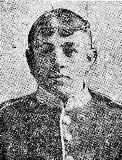
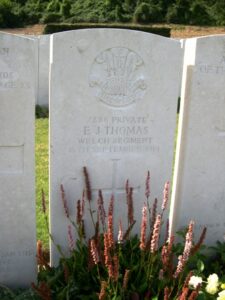
John Thomas, Private, 58427, South Wales Borderers. John was born in 1898, the son of James Thomas and Margaret Thomas, of 11, Standing Street, Gwaun-cae-Gurwen. He enlisted at Cardiff into the army and was posted to Kinmel Park to join one of the Training Reserve Battalions. John was drafted to France in the summer of 1918, joining the 10th Battalion, South Wales Borderers, which was attached to 115 Brigade, 38th (Welsh) Division. The Division had been in France since December 1915, and had fought at Mametz Wood in 1916, then at Ypres in August 1917 before being transferred to the Sailly-sur-la-Lys sector in September, and remained in the area over the winter before being moved to positions north of Albert, at Bouzincourt Ridge, at the end of March 1918, relieving the battered 2nd and 47th Divisions. It held this sector, again carrying out minor operations and trench raids, over the coming months. On 21 August 1918 the Division launched an assault across the River Ancre, as part of the greater Allied offensive, and over the coming days captured Thiepval Ridge, Pozieres, Mametz Wood and High Wood, whilst advancing across the old Somme battlefields of 1916. The advance saw the Division take part in several costly assaults over the coming weeks, famously crossing the Canal du Nord, and then once the Hindenburg Line had been breached, the Division advanced north-east, past Le Cateau, towards the Forest of Mormal, forcing the crossing of the River Selle. John was killed in action whilst the 10th SWB was holding the bridgeheads across the Selle on 17 October 1918. The 20-year-old is buried in Cross Roads Cemetery, Fontaine-Au-Bois, France.

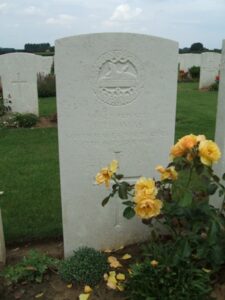
Morgan Walters, Flight Sergeant, 2478, Royal Air Force. Morgan was born in 1893, the son of Thomas Walters and Mary Anne Walters (nee Thomas), of 6, Twynyrefail Place, Gwaun-Cae-Gurwen. He trained as a carpenter prior to the war, and with his woodworking skills, enlisted into the Royal Flying Corps on 2 December 1914, training as a aircraft fitter. Morgan then went out to the Western Front with one of the RFC squadrons on 15 January 1915 and was obviously good at his job, as he rose to the rank of flight sergeant over the coming years. He remained in the service following the merger of the Royal Flying Corps and the Royall Naval Air Service to form the Royal Air Force in March 1918. After the armistice Morgan was posted to ‘E’ Reserve and returned home to Gwaun-cae-Gurwen. He died at home on 30 December 1920. The 27-year-old was buried in Carmel Burial Ground, Gwaun-Cae-Gurwen. He is not commemorated on the Gwaun-cae-Gurwen war memorial.
David William Watkins, Private, 37701, Royal Welsh Fusiliers. David was born in 1894, the son of John Watkins and Margaret Watkins (nee Thomas), of The Old Star Hotel, Cwmgorse. He was educated at Taunton before becoming a Solicitor’s Clerk at Swansea. David enlisted at Swansea on 10 December 1915 into the Royal Welsh Fusiliers, and moved to France on 25 June 1916, being posted to the 1st Battalion, Royal Welsh Fusiliers. The battalion was attached to 22 Brigade, 7th Division, and was in positions near Fricourt, on the Somme, when David arrived. The battalion included the war poets Siegfried Sassoon and Robert Graves and the author Bernard Adams among its officers. David would have taken part in the battalions attack on Mametz village on 1 July 1916, one of the few successes of the opening day of the Battle of the Somme. He was killed in action two weeks later, during the attacks on High Wood on 14 July 1916. The 22-year-old has no known grave and is commemorated on the Thiepval Memorial, France.
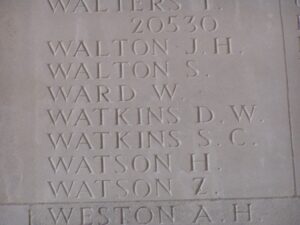
Bert Williams. Bert cannot be positively identified. He is not named among the original 33 casualties who were the subject of the first memorial service after the war.
Evan John Williams, Lance Serjeant, 11548, South Wales Borderers. Evan was born at Treharris in 1895, the son of John Williams and Matilda Williams. By 1911 he had left home and was lodging at Gron Road, Gwaun-cae-Gurwen. Evan enlisted into the South Wales Borderers at Brecon soon after the outbreak of war. He was drafted to the Middle East in June 1915 to join the 2nd Battalion, South Wales Borderers, which was at Gallipoli, attached to 87 Brigade, 29th Division. Evan landed at Gallipoli on 15 June, joining the battalion in the trenches at Geoghegan’s Bluff. Two days later the battalion moved into the line at Gully Ravine and on the following day endured a horrific artillery bombardment upon their positions. The battalion was relived on 24 June and moved to rest positions on Gully Beach, then on 28 June moved back into the line to begin another spell in the trenches. Evan was wounded around this time and was evacuated by a Hospital Ship to one of the hospitals in Malta. He died of his wounds there on 4 July 1915. The 20-year-old is buried in Pieta Military Cemetery, Malta. His medals and memorial plaque were recently sold at auction.
Evan Lewis Williams, Guardsman, 901, Welsh Guards. Evan was born in 1895, the son of John and Mary Williams, of Frondolau, Aberarth, Cardiganshire. He served an apprenticeship as a mason as a young man and lodged at Brynhenllan, Seven Sisters. Evan then resided at Cwmgorse prior to the war. He enlisted at Neath into the 1st Battalion, Welsh Guards soon after its formation. The Regiment had been raised by Royal Warrant of 26 February 1915, at White City, before landing at Le Havre on 18 August 1915, becoming attached to 3rd Guards Brigade, Guards Division. The Division saw its first major action during the Battle of Loos, which began on 25 September 1915 and suffered terrible casualties during the fighting for Hill 70 and the ensuing Action of the Hohenzollern Redoubt. The Division had a brief rest in the Calais area, before moving to the Ypres Salient, and held the line at Potijze for several months. At the end of July 1916, the Division withdrew from Ypres and moved to the Somme, before holding the line north of the Ancre for a short period. By 25 August the Guards Division had moved slightly south, and had marched passed Corbie, to Mericourt-L’Abbe. By 9 September the Guards had passed Ginchy, and moved into positions at Guillemont, prior to taking part in the Battle of Flers-Courcelette, the first-time tanks were ever used in action. The Guards Division saw heavy fighting at Flers, and then during the ensuing Battle of Morval, capturing Lesboeufs Village. After the Somme offensive had died down, the Guards remained on the Somme for the winter. Later that year the Guards moved north to Ypres, taking over positions on the left flank of the 38th (Welsh) Division, on the northernmost part of the line near Boesinghe. Evan was wounded during the build up to the Battle of Pilckem Ridge and died of his wounds on 28 July 1917. The 22-year-old is buried in Dozinghem Military Cemetery, Belgium. Evan is not commemorated on the Gwaun-cae-Gurwen war memorial.
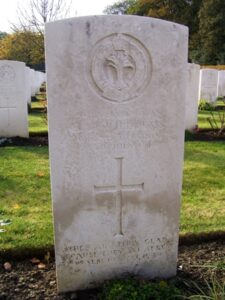
Ivor Maldwyn Williams, Private, 15428, Royal Welsh Fusiliers. Ivor was born in 1895, the son of John Williams and Rachel Williams (nee Jones), of Pwllwrach, Gwaun-cae-Gurwen. He enlisted into the 10th Battalion, Royal Welsh Fusiliers. The battalion had formed at Wrexham in September 1914, joining 76 Brigade, 25th Division at Codford St. Mary, Salisbury Plain. In November 1914 the battalion moved to billets at Bournemouth, then at the end of April 1915 moved to Romsey before moving again to Aldershot to complete its training. The battalion landed at Boulogne on 27 September 1915 and the entire division moved to the Ypres Salient for trench initiation. 76 Brigade then transferred to the 3rd Division, before taking over the line at St. Eloi, near Ypres. The Division saw heavy fighting during the Actions of the Bluff in February 1916 and then at the Actions of the St Eloi Craters from 27 March to 16 April. The division was then moved south to the Somme, and fought there at the Battle of Albert, and the Battle of Bazentin, where it captured Longueval. The division then took part in the Battle of Delville Wood, where the 10th RWF was caught up in fighting of such severity that two men of the battalion were awarded the Victoria Cross. On 25 July the shattered battalion was relieved and moved into reserve, and did not move back into the line until 17 August, when the battalion attacked Lonely Trench. The division then had a brief rest before taking part in the Battle of the Ancre, before settling into another bleak winter in France. In May 1917 the Division was at Arras, and fought at the First and Second Battles of the Scarpe, at the Battle of Arleux and the Third Battle of the Scarpe, where it captured Roeux. Later that year the division moved back to Ypres, where it fought at the Battle of the Menin Road and the Battle of Polygon Wood. In November the Division moved south again and fought at the Battle of Cambrai, remaining in the area over the winter. On 8 February 1918 the 10th RWF was disbanded , with most of its men going to the 8th Entrenching Battalion. Ivor was transferred to the 14th Battalion, Royal Welsh Fusiliers, which was attached to 113 Brigade, 38th (Welsh) Division, which was near Armentieres. The division was moved to positions near Albert on the Somme in March 1918 and remained there until 21 August 1918 when it began its epic attack across the Ancre, driving the Germans back beyond the Hindenburg Line within several weeks of heavy fighting. During the last few days of the war, the Division was involved in desperate fighting around the Forest of Mormal. Ivor took ill towards the end of the war, and was evacuated to the Base Hospital at Rouen for treatment. After surviving all of those dreadful battles, he died of influenza at Rouen on 15 November 1918. The 24-year-old is buried in St. Sever Cemetery Extension, Rouen, France. After his father died his mother remarried, becoming Mrs. Rachel Rees, of 12, Water Street, Gwaun-Cae-Gurwen.
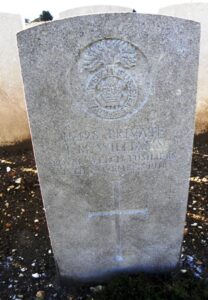
John Williams. John cannot presently be identified. He resided at Morriston Place, Gwaun-cae-Gurwen.
Percy Williams, Lance Corporal, 11274, Welsh Regiment. Percy was born at Cardiff on 3 June 1896, the son of Thomas Williams and Alice Williams (nee Lewis). After Alice’s death at Swansea in 1905, his father married Caroline Jane Bevan and the family moved to 59, Colbren Road, Gwaun-Cae-Gurwen. Percy drove an electrical engine at the Gwaun-cae-Gurwen Collieries prior to the war. He enlisted at Swansea into the Welsh Regiment on 14 August 1914, and was posted to France in February 1915 to join the 2nd Battalion, Welsh Regiment which was attached to 3 Brigade, 1st Division and was holding the line north-east of Bethune, near Richebourg. The 1st Division took part in its first major action of 1915 here on 9 May 1915, during the Battle of Aubers Ridge, when it attacked alongside the Meerut Division. The attack of the 2nd Welsh was held up by a flooded ditch, which the men forded, before being hit by heavy machine-gun fire, and a large number of casualties were suffered before the survivors withdrew. After the battle of Aubers, the 2nd Welsh took over a section of old French trenches, where it received drafts of reinforcements. On 20 May, the Battalion was moved to the Cuinchy area, where it endured a great deal of bombing and rifle grenading, then at the latter end of June the Battalion moved to the Vermelles area, in preparation for the battle of Loos. The Battle of Loos was launched on 25 September 1915, following the release of large quantities of poison gas by the British. 3 Brigade moved off with the 2nd Munsters on the right, the 2nd Welsh in echelon, to their left, and the 1st SWB in support. The gas had blown back over the British lines, so conditions during the advance were horrendous, then whilst advancing past the Vermelles-Hulluch Road the Brigade came under heavy machine-gun fire. Colonel Prothero, undaunted, drove the 2nd Welsh forward towards the German third line, Gun Trench, some 1,000 yards behind their first line, towards Hulluch, but the battalion soon found it was cut-off and surrounded. The battered battalion was then relieved and refitted before going back into the line, remaining in the Loos sector over the winter. During July 1916 the Division moved south, to join the great Somme offensive, and the 2nd Welsh reached Albert by 11 July, taking up billets in the town. On the morning of 15 July the 2nd Welsh received orders to proceed via the recently captured Mametz Wood to the new front line, facing Bazentin Ridge, and took over positions near Bazentin-le-Petit Wood. On the following morning the battalion took part in its first assault on the Somme, but came under intense machine-gun fire, forcing the battalion to withdraw. On 19 July, after a torrid spell in the line, the 2nd Welsh was relieved and moved into reserve for a rest. The 2nd Welsh moved back into the front line southeast of Pozieres, on 25 July and on the following morning, 26 July 1916, launched an assault on Munster Alley. Percy was killed in action during the terrible fighting that day. The 20-year-old has no known grave and is commemorated on the Thiepval Memorial, France.
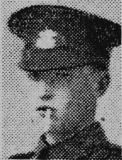
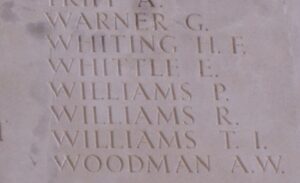
Peter Williams, Private, 201130, Welsh Regiment. Peter was born at Llanedy in 1882, the son of David Williams and Catherine Williams (nee Lewis). He married Elizabeth Ann Richards in 1904 and on 22 May 1906 she gave birth to their son Sydney. By 1911 Peter was lodging at Brook Street, Gwaun-cae-Gurwen, and worked there as a bricklayer. Peter had enlisted into the Welsh Regiment Militia at Pantyffynon on 14 October 1907, and during the following year the battalion became the 4th Battalion, Welsh Regiment. He was mobilised with the 4th Welsh at the outbreak of war and joined the battalion in Carmarthen, where it was attached to the South Wales Brigade, Welsh Division. The 4th Welsh moved to Tunbridge Wells until the end of the month, before moving to Scotland to man the Forth and Tay Defences. On 17 April 1915 the battalion moved to Bedford, joining the now renumbered 158 Brigade, 53rd (Welsh) Division. On 19 July 1915 the entire Division sailed from Devonport for Imbros and on 9 August 1915 landed at Suvla Bay. The infantry moved off the beaches across the Salt Lake, under shellfire, into the scrub covered Chocolate Hill, but due to a lack of maps and no knowledge of the terrain, many of the units became disorientated, and the situation became chaotic. After the fighting died down, the winter rolled in, and the men first had to endure torrential downpours, which flooded the trenches, before the snow hit, and many men began falling ill in the terrible conditions. The Division was eventually evacuated from Gallipoli in December 1915, moving to Egypt to join the EEF, and helped guard the Suez Canal before taking part in operations to drive the Turks out of the Sinai. The EEF then turned its attention onto driving the Turks out of Palestine, and on 26 March 1917 launched its first offensive against the coastal city of Gaza, which guarded the road to Jerusalem. Initial gains during the day were lost when the assaulting divisions lost touch with each other and communication broke down when a thick fog cloaked the battlefield. Peter was killed in action here on 26 March 1917. The 35-year-old has no known grave and is commemorated on the Jerusalem Memorial, Israel.
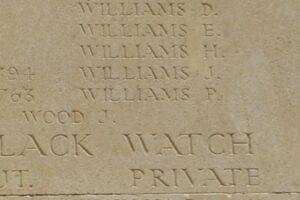
William Williams, Private, 13175, Hampshire Regiment. William was born at Llangattock in about 1888. He came to Cwmgorse to find work as a young man and in 1901 married Elizabeth Jones. The couple settled at Pontardawe Road, Cwmgorse. William enlisted at Pontardawe into the 12th Battalion, Hampshire Regiment soon after the outbreak of war. The battalion formed at Winchester in October 1914, moving to Codford to join 79 Brigade, 26th Division. In November 1914 the battalion moved to Basingstoke in billets, then in March 1915 moved to Bath, before moving again to Sutton Veny. The entire division then embarked for France on 21 September 1915, moving to the Somme sector for trench initiation. The Division’s stay in France was to be very short, however, as on 15 November 1915 the Division, having been moved by train to Marseilles, began to embark for Salonika as part of an Anglo-French force sent to hold the Greek border, due to the invasion of neighbouring Serbia by a combined Austro-Hungarian force. The Division remained in the Salonika theatre for the rest of the war, taking part in the Retreat from Serbia during December 1915. Large battles were fought in August 1916, at the battle of Horseshoe Hill, then in September 1916 at the battle of Machukovo. On 24 April 1917 the Battle of Doiran commenced. William was killed on the second day of the fighting, on 25 April 1917. The 29-year-old is buried in Doiran Military Cemetery, Greece.

George Henry Wilson, Private, 11371, Welsh Regiment. George was born at Islington in 1884, the son of David Wilson and Jane Wilson (nee Glover). He came to South Wales to find work as a young man, initially residing with his brother at Pontardawe, before moving to 24, Brook Street, Gwaun-cae-Gurwen, where he gained work as a collier. George enlisted at Cardiff into the 8th Battalion, Welsh Regiment soon after the outbreak of war. The battalion had formed at Cardiff, initially attached to 40 Brigade, 13th (Western) Division, then in January 1915 was converted into the Pioneer Battalion to the 13th Division. Towards the end of February the entire Division concentrated at Blackdown in Hampshire, and on 13 June 1915 the Division sailed to Alexandria. By 4 July, all units had moved to Mudros, preparatory for landing on Gallipoli. Between 6 and 16 July 1915 the Divisional infantry landed on Cape Helles and relieved the 29th Division, which had been there since the landings of 25 April. The division then left and returned to Mudros at the end of the month, before landing at ANZAC Cove from 3 August 1915, to take part in a great diversionary offensive, intended to draw Turkish attention away from fresh landings at Cape Helles. On the night of 6/7 August the 8th Welsh advanced from the beach to Chailak Dere, in support of an attack on Chunuk Bair, bivouacking on Rhododendron Ridge. At dawn on 8 August 1915 the 8th Welsh moved forward in support of an assault by the 7th Gloucesters and the Wellington Regiment upon Chunuk Bair, watching as the attacking battalions came under heavy fire. Then the 8th Welsh advanced, entering the fight, and came immediately under heavy fire themselves. George was killed here during this assault on 8 August 1915. The 27-year-old has no known grave and is commemorated on the Helles Memorial, Gallipoli.
Frederick Worby, Private, 17985, Suffolk Regiment. Frederick was born in 1878, the son of Henry Worby and Caroline Worby (nee Clutterham), of Little Livermere, Suffolk. He married Florence Arbon in 1898 and the couple lived at Curatage Cottage, Caston, Attleborough, Norfolk. Frederick had come to Cwmgorse to work prior to the war and lodged there with his cousin, Albert Worby. He returned to Norfolk to enlist at Brandon into the Suffolk Regiment and was posted to the 11th Battalion, Suffolk Regiment, which was attached to 101 Brigade, 34th Division. The Division moved to France in January 1916, and moved to Flanders, to the Bois Grenier area, for trench initiation and training. In May the division was relieved and moved south to the Somme, where it took part in the opening assault on La Boiselle on 1 July, suffering heavy casualties. The division rested before taking part in the Battle of Bazentin Ridge soon afterwards, then saw further fighting during the Battle of Pozieres and the Battle of Flers-Courcelette. The following year saw them fighting at the Battle of Arras, seeing heavy fighting again during the First and Second Battles of the Scarpe, then during the Battle of Arleux. The Division then moved to the Ypres Salient at the end of September, the 11th Suffolks arriving at Elverdinghe by 8 October and moved to Soult Camp. The battalion was then put to work on road repairing and trenches, in terrible conditions, around Stray Farm. Frederick became wounded there on 14 October, suffering shrapnel wounds to his stomach, and was evacuated to the Casualty Clearing Station at Mendinghem, where he died of his wounds on the following morning, 15 October 1917. The 40-year-old is buried in Dozinghem Military Cemetery, Belgium.
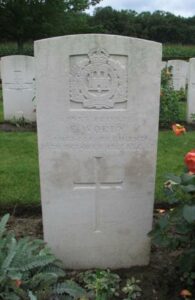
World War Two, 1939-1945
Daniel Winston Davies, Fireman, Auxiliary Fire Service. Daniel was born on 19 December 1909, the son of John Davies and Ann Davies, of High Street, Cwmgorse. He married Gwyneth Howell in 1937 and the couple lived at Glan-y-Gorse, Cwmgorse. Daniel worked as a turf accountants clerk prior to the war. He volunteered to serve with the Auxiliary Fire Service following the outbreak of war and was posted to Swansea. Daniel died while fighting a fire at Welcome Lane, Swansea, which was caused by a German Air Raid on 21 February 1941. He was 31 years old, and is buried in Old Carmel Cemetery, Gwaun Cae Gurwen.
David Gordon Davies, Sergeant, 1313560, Royal Air Force Volunteer Reserve. David was born in 1921, the son of David James Davies and Sarah Davies (nee Thomas), of Gwaun-cae-Gurwen. He enlisted into the Royal Air Force Volunteer Reserve and after completing his training was posted to 204 Squadron, Royal Air Force. At the outbreak of war 204 squadron began patrols over the English Channel and the Western Approaches and was equipped with a variety of amphibious aircraft. After the invasion of Norway in April 1940, the squadron moved to Shetland to patrol the North Sea. In April 1941 it moved to Iceland, and in July 1941 was sent to Gibraltar, before heading to RAF Bathurst in Gambia in West Africa, where it was utilised in anti-submarine duties. On 29 November 1942, David was flying aboard a Short Sunderland III of 204 Squadron when it was lost over the Bay of Biscay, whilst en-route from Mount Batten, Plymouth to Bathurst. The 21-year-old has no known grave and is commemorated on the Runnymede Memorial, Surrey.
Glyn Davies. Glyn cannot be positively identified.
Kenneth Davies, Trooper, 7956007, 2nd Lothians and Border Horse. Kenneth was born in 1921, the son of William Davies and Edith Davies (nee Hughes), of Derwydd Avenue, Gwaun-cae-Gurwen. He enlisted into the army and was posted to the 2nd Lothians and Border Horse. The battalion had been formed after the outbreak of war and joined the newly formed 1st Motor Machine Gun Brigade. On 12 September 1940, the regiment was converted to an armoured formation, joining the 26th Armoured Brigade of the Royal Armoured Corps, as part of the newly formed 6th Armoured Division. The regiment was equipped with Crusader cruiser tanks, as well as a number of Valentine and Matilda infantry tanks, before embarking for North Africa in late 1942, to join the campaign in the Western Desert. Following the surrender of the Afrika Korps in May 1943, the regiment took part in the Italian Campaign. Kenneth was killed in Italy on 17 May 1944. The 22-year-old was originally buried on the battlefield, but after the war his grave was exhumed and he was re-interred in Cassino War Cemetery, Italy.
David Morgan Ellis, Sergeant (Flight Engineer), 1031023, Royal Air Force Volunteer Reserve. David was the son of David and Jane Ellis, of Pontypridd. He married Iris May Jones, of Cwmgorse, at London in 1940. David enlisted into the Royal Air Force Volunteer Reserve and after training as a Flight Engineer was posted to 101 Squadron, Royal Air Force. The squadron was equipped with Blenheim IVs and was involved in attacks against enemy barge concentrations in the Channel Ports. In mid-1941, 101 Squadron became part of Bomber Command’s medium-bomber force with Wellingtons and flew many night sorties against Germany and Italy. These aircraft were replaced barely 18 months later by the Lancaster and became specialised in airborne radar jamming to disrupt German night-fighters interceptions. David was one of the crew members of Lancaster ED328, radio call-sign SR-S (S-Sugar) of 101 Squadron. In the photograph below, having just returned from an operational sortie over Germany, from left is 1451351 Sgt John Henry Phillips, RAF (Mid-Upper Gunner); 415104 Flight Sergeant Douglas John Tresidder, RAAF; 416601 F/Sgt Robert Clarence Naffin, RAAF (Pilot); and 1031023 Sgt David Morgan Ellis. On the night of 23/24 August 1943, Lancaster ED328 failed to return from an operational sortie over Berlin. It was later determined that ED328 had been shot down over Lanke, 20 miles north-east of Berlin, killing all seven members of the crew. All of the men are buried at Berlin 1939-1945 War Cemetery, Germany. David is not commemorated locally. (Photograph courtesy of the Australian War Memorial).
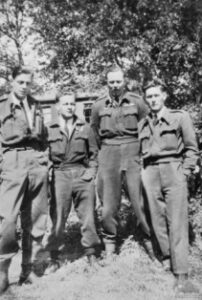
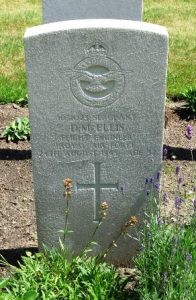
John Vernon Evans, Flight Lieutenant (Navigator), 124672, Royal Air Force Volunteer Reserve. John was born on 10 June 1918, the son of David John Evans and Hannah Jane Evans (nee Davies), of Gwaun-cae-Gurwen. He had studied for Holy Orders, gaining his B.A. at Lampeter University prior to the war. John enlisted into the Royal Air Force Volunteer Reserve and trained as a Navigator before being posted to 109 Squadron, Royal Air Force. The squadron had reformed on 10 December 1940 from the Wireless Intelligence Development Unit at RAF Boscombe Down operating a variety of aircraft, tasked with identifying German radio beams and in developing methods to jam them, as well as developing wireless and radar navigation aids for RAF Bomber Command. In 1942 the squadron moved to RAF Stradishall with the de Havilland Mosquito light bomber fitted with Oboe and then moved to RAF Wyton where it formed part of the Pathfinder Force. On 2 April 1944 the squadron moved to RAF Little Staughton, in Bedfordshire. On 4 March 1945 John took off from Little Staughton aboard a Mosquito BXVI, Serial PF447, piloted by Alfred Payne, as part of a Pathfinder Force sent to mark targets at Hallendorf. The mission had been successfully carried out and the Mosquito headed for home. Unfortunately the aircraft crashed whilst landing at Melsbroek Airfield near Brussels on the morning of 5 March 1945. John was 26 years old, and is buried next to Alfred in Brussels Town Cemetery, Belgium.
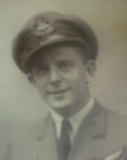
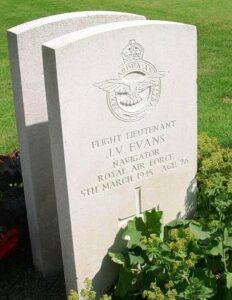
William Rufus Griffiths, Private, 3967410, Welch Regiment. William was born in 1919, the son of John Sidney Griffiths and Elizabeth Ann Griffiths, of 39, Crescent Road, Gwaun-cae-Gurwen. He enlisted into the army and embarked for Palestine with the 1st Battalion, Welch Regiment in May 1939. The battalion struggled to maintain peace between the Jews and Arabs during its time in Palestine and the men were no doubt happy when the battalion left for Egypt in November 1939. The battalion moved to Mersa Matruh, then on 28 February 1940 the battalion embarked for Crete. The men then began to dig-in and prepare positions for an expected German invasion, which materialised on 14 May 1941 when some 600 German bombers began saturation bombing the island, followed by the landing of hundreds of elite German paratroopers. The 1st Welch fought a stubborn defensive effort, but were forced to withdraw to Suda Bay, where the bulk of the battalion was captured. Some 300 men managed to reach Sphakia and embarked upon a Royal Navy ship for evacuation to Alexandria but were again overwhelmed when they were caught up in the ferocious fighting at Benghazi. William was possibly taken POW at Crete, and died in Greece on 30 May 1941. The 21-year-old was buried in Kokkinia Civil Cemetery, but February 1945 his grave was exhumed and he was re-interred in Phaleron War Cemetery, Greece.
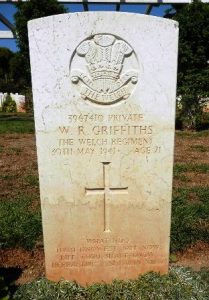
Edgar Hopkin, Leading Aircraftman, 1381675, Royal Air Force Volunteer Reserve. Edgar was born in 1922, the son of William Hopkin and Rachel Hopkin (nee Walters), of 13, Crescent Road, Gwaun-cae-Gurwen. He enlisted into the Royal Air Force Volunteer Reserve and was sent to America to take part in the Commonwealth Air Training Scheme, to train as a pilot. Edgar was sent to Napier Field, Alabama, to join the 433rd School Squadron, Advanced Flying School, USAAF. On 20 January 1942, Edgar took off from Napier Field, flying solo in a US North American At-6a Texan on a night cross-country exercise. He became lost during the exercise and ran out of fuel, before crashing near Verbena, Alabama and was killed. The 19-year-old was buried in New Castle (Castle View) Burial Park, Pennsylvania, USA.
Benjamin Cynddylan Jones, Flying Officer, 142452, Royal Air Force Volunteer Reserve. Benjamin was born in 1921, the son of David John Jones and Sarah Ann Jones (nee Williams), of 18, Derwydd Avenue, Gwaun-cae-Gurwen. He enlisted into the Royal Air Force Volunteer Reserve and after training as an Air Bomber was posted to 166 Squadron, Royal Air Force. The Squadron was formed at RAF Kirmington, in Lincolnshire, equipped with Vickers Wellingtons, and joined the night bombing offensive, re-equipping with Avro Lancaster’s in September 1943. On 24 March 1945, 173 Lancaster’s and 12 Mosquitos of Nos 1, 6 and 8 Groups attacked the Harpenerweg plant at Dortmund and the Mathias Stinnes plant at Bottrop. Benjamin had taken off from Kirmington as part of the crew of Avro Lancaster III, Serial ND620. Three Lancaster’s were lost on the Dortmund raid, one of which was Benjamin’s, ND620, although two of his fellow crewmen managed to bale out. Benjamin was 22 years old when he was killed in the crash and was originally buried alongside his four other crewmen in Selledoorf Cemetery, Germany. After the war their graves were exhumed and identified and the five men were buried together in Berlin 1939-1945 War Cemetery, Germany.
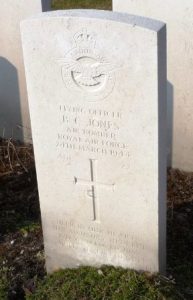
David John Jones, Sergeant, 1316138, Royal Air Force Volunteer Reserve. David was born in 1917, the son of Charles Jones and Blodwen Jones (nee Oxenham), of Gwaun-cae-Gurwen. He married Nellie Jones, of Gwaun-cae-Gurwen, in the summer of 1943. David enlisted into the Royal Air Force Volunteer Reserve and after training as a Wireless Operator/ Air Gunner was posted to 103 Squadron, Royal Air Force, which was a heavy bomber squadron, based at RAF Elsham Wolds in Lincolnshire and equipped with the Avro Lancaster. On the evening of 24 May 1944 David took off from Elsham Wolds aboard an Avro Lancaster III, Serial ND624, as part of a thousand bomber raid on Aachen, Germany. David’s Lancaster was intercepted by a German night fighter in the early hours of 25 May 1944 and was shot down, crashing at Sistig, some three miles Southeast of Schleiden, killing all seven men aboard. David was 27 years old when he died in the crash. He was originally buried alongside his fellow crewmen in a mass grave in Sistig, but after the war the remains of the seven men were exhumed and buried together in Rheinberg War Cemetery, Germany.
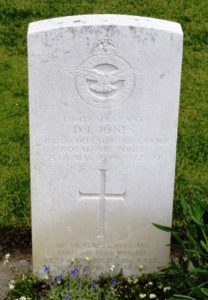
John Kavanagh, Ordinary Seaman, Merchant Navy. John was born in Kingstown, Dublin in 1919, the son of Andrew Kavanagh and Ethel Kavanagh (nee Young). He lodged with his sister, Mrs W. Jones, at Tivy House, Gwaun-cae-Gurwen prior to the war. John enlisted into the Merchant Navy soon after the outbreak of war and was posted aboard the Swansea registered SS Henri Mory, a French built steamship which had been seized by the Admiralty at Swansea in July 1940 and transferred to the Ministry of War Transport. On 27 April 1941, Henri Mory was steaming unescorted, straggling from Convoy SL-68, when she was torpedoed by the German submarine U-110, which hit her in the engine room. The crew of 30 men and two gunners began to abandon ship, but the darkness and a heavy swell caused one lifeboat to drift away. The doomed ship sank within four minutes, taking down her master, 25 crew members and two gunners. John was 22-years-old when he was lost in the sinking of Henri Mory. He has no known grave so is commemorated on the Tower Hill Memorial, London. John is not commemorated on the Gwaun-cae-Gurwen war memorial.
Herbert Lewis, Fireman, Auxiliary Fire Service. Herbert was born on 27 October 1903, the son of David and Margaret Lewis, of 57 Neuadd Road, Gwaun-cae-Gurwen. He married Annie Lizzie Williams in 1926 and the couple settled at 19 Amman Road, Brynamman. Herbert served as a fireman prior to the war, the was posted to the Auxiliary Fire Service following the outbreak of war. Herbert died while fighting a fire at Castle Lane, Swansea after a German Air Raid on 21 February 1941. He was 37 years old.
Arthur David Michael Merretti, Leading Aircraftman, 1107250, Royal Air Force Volunteer Reserve. Arthur was born at Cheltenham in 1920, the son of David Morgan Davies Merretti and Alice Margaret Merretti (nee Bullock). After the death of his mother in 1933, the family came to live at Cwmgorse. Arthur enlisted into the Royal Air Force Volunteer Reserve and trained as a pilot, before being posted to No 9 Service Fighter Training School, which was based at RAF Hullavington, in Wiltshire. On 8 July 1941, Arthur was flying a Hawker Hurricane I, Serial L1832 of No 9 SFTS, when he stalled the aircraft and crashed on the approach to Castle Combe during a training flight, killing him instantly. Arthur was 20 years old, and is buried at Chippenham (London Road) Cemetery, Wiltshire.
David John Atherley Watcyn Price, Flight Sergeant, 1322377, Royal Air Force Volunteer Reserve. David was born in 1921, the son of David Price and Anne Price (nee James), of 23, High Street, Cwmgorse. He enlisted into the Royal Air Force Volunteer Reserve, and trained as a pilot before being posted to 197 Squadron, Royal Air Force. The squadron reformed on 21 November 1942 at RAF Turnhouse and was supplied with Hawker Typhoons, and operated at different times from RAF Manston, RAF Tangmere and RAF Hurn. The squadron supported the Normandy landings in June 1944, before re-locating to Ste Croix-sur-Mer, France, where it supported the Allied advance. On 17 August 1944 David was on patrol over France when he was shot down and crashed near Vimoutiers, some five miles Southeast of Livarot and was killed. The 23-year-old was originally buried at St Ouen Le Houx, but in June 1946 his grave was exhumed and he was re-interred in St. Desir War Cemetery, France.
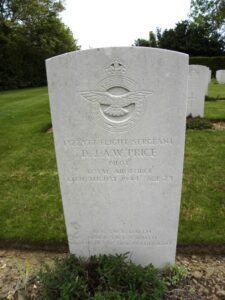
Ceirionedd Rhys, Private, 7374784, Royal Army Medical Corps. Ceirionedd was born in 1920, the son of David Rhys and Ann Rhys (nee Jeremiah), of 4, Garth Road, Gwaun-Cae-Gurwen. He enlisted into the army and was posted to India the 6th Field Ambulance, Royal Army Medical Corps. Ceirionedd served in the Far East during his short time at war, and died in India on 2 June 1943. The 23-year-old was buried in Delhi War Cemetery, India.
Howell John Rees, Private, 6026955, Cambridgeshire Regiment. Howell was born at Llandybie on 29 March 1915, the son of Edward John Rees and Elizabeth Rees (nee Morgan). The family later resided at 44, Llwyn Road, Cwmgorse. He worked as a coal hewer prior to enlisting into the army and was posted to the 2nd Battalion, Cambridgeshire Regiment. The battalion was sent to Singapore in early 1942 and reinforced the 15th Indian Brigade at Batu Pahat. Singapore was the foremost British military base and economic port in South–East Asia and was known as the ‘Gibraltar of the East’. It was strongly garrisoned and was thought to be impregnable. On 8 December 1941 the Japanese launched a series of simultaneous attacks against Pearl Harbour, Malaya, Thailand and the Pacific Islands. The Japanese had a force of some 30,000 troops involved in the Malayan invasion but soon reached the outer defences of Singapore following a short period of intense fighting. General Percival, commanding a garrison of some 85,000 troops in Singapore was ordered by Winston Churchill to fight to the last man, however, on 15 February 1942 he surrendered, and 80,000 troops were marched into captivity. Howell was marched into captivity, together with the survivors of his battalion, and was incarcerated at Changi Jail. He was later sent to a POW Camp in Thailand, to work on the Thai-Burma Railway. Howell survived the war, but was very ill upon his release and died in Burma on 15 September 1945. The 30-year-old was buried in Rangoon War Cemetery, Myanmar.
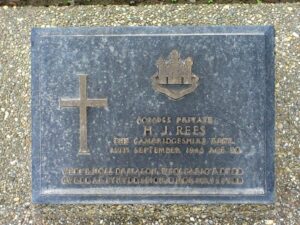
Post WW2
William Gethin Jones, Able Seaman, D097619N, Royal Navy. William was born at Gwaun-cae-Gurwen on 15 June 1949. He served in the Royal Navy aboard HMS Warspite. HMS Warspite was the third of Britain’s nuclear-powered submarines, and was launched on 25 September 1965 by Mary Wilson, the wife of Prime Minister Harold Wilson, entering service 18 April 1967. William was just 24 years old when he died on active service at Faslane RN port on 17 March 1974. He is buried in Ulverston Cemetery, Cumbria.